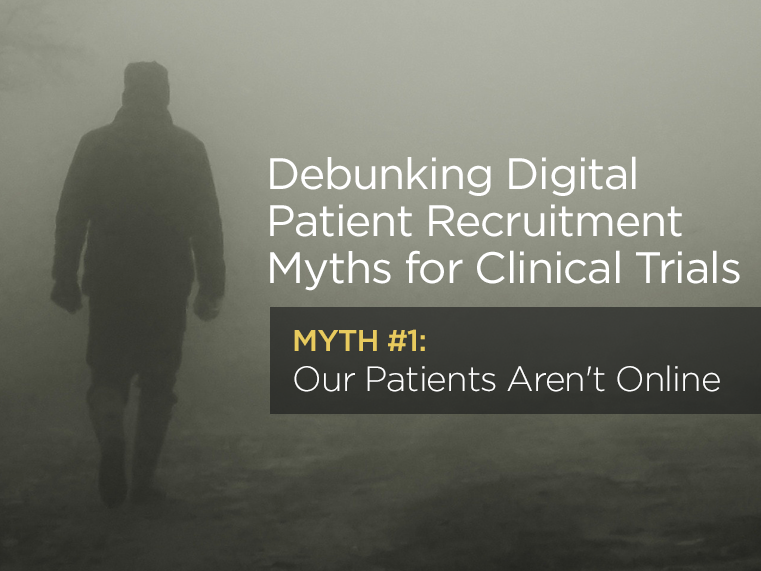Debunking Digital Patient Recruitment Myths for Clinical Trials: Myth #1

When it comes to clinical trial recruitment, fiction often rules the day. In this series, we debunk some of the most common misperceptions about digital recruitment for clinical trials, and set the record straight with hard facts and actionable solutions.
Healthcare and medical consumers have officially entered the digital age – unfortunately, the Bio/Pharma and Medical Device space has been slow to follow suit. Pharma digital investment still only accounts for 3-6% of the total marketing spend, which is somewhat concerning when you consider that 72% of consumers searched for health-related information online in the last year, according to Pew Internet.
It’s not as though digital tools haven’t suitably evolved to benefit clinical trial recruitment – rather, comparatively ineffective marketing efforts remain popular because of persistent misperceptions about digital methods. In other words, myth and misinformation (along with a long list of complex regulations) have kept measurably powerful recruitment techniques from breaking into the the mainstream.
That’s unacceptable, especially considering that most trials today last nearly twice as long as intended because of enrollment issues, according to Tufts University research.
More Myths, More Missed Opportunities
It’s no secret that clinical trial recruiters have been slow to embrace innovative, digital marketing techniques. But as consumer trends and habits become increasingly internet-focused, clinical trial recruiters must adapt accordingly – remember, it’s the consumers that drive the market, not the other way around.
For example, smartphone penetration in the U.S. has already reached 77% ( 90% among users 18-24), according to comScore. Of those users, Pew Internet explains how 52% use their smartphone to search for health information online, and that number is growing by the minute. Not only are mobile devices now the most-used digital platform for connecting to the web, health information is the fastest-growing content category for mobile users, according to Deloitte.
Moreover, nearly every patient demographic is taking to online communities to find support and share opportunities for treatment. As NBCI research has found, those patient communities form accurate, representative samples of real-world patient groups (the study concerned scoliosis, specifically). That’s also important, because 62% of Americans with one or more chronic diseases go online in search of information and support, according to Pew Internet.
Probably one of the biggest misconceptions among trial sponsors and CROs is that they need to stick to traditional recruitment channels when targeting the elderly, as older patient demographics aren’t online. The latest data suggests the exact opposite: 77% of those 50-64 are online, as are 63.7% of people aged 65 and older, according to Emarketer. What’s more, the 65+ demographic is expected to grow to 71% by 2019.
With more than 10,000 baby boomers turning 65 on a daily basis, as Forbes reports, the opportunity for senior recruitment is obviously there &mash; it’s simply a question figuring out how to reach them in the simplest, most effective way possible.
Why Digital Makes Sense for Every Demographic
Still think your “patients aren’t online?” Let’s make the counterargument a little more tangible: every month in the U.S., consumers conduct four million Google searches on eczema, 2.5 million on sciatica, and two million on emphysema. When you pan out to include other search engines and social platforms, that number balloons by 20-25%. Out of the 100 billion monthly Google searches, 1 in 20 is health-related.
But it’s not just a question of capitalizing on the high volume &mash; e-recruitment is more cost-effective and impactful than traditional methods. Thanks to the increased flexibility, highly-specific targeting, tracking, and optimization of digital campaigns, many trial sponsors and recruitment companies are able to cut their overall costs by as much as 75%.
Don’t let myths and misinformation get in the way of success &mash; seek out the facts and guidance needed to overcome the obstacles unique to clinical trial recruitment. Then sit back and watch as your overall marketing spend goes down while enrollment numbers surge.

 Back to Blog Home
Back to Blog Home